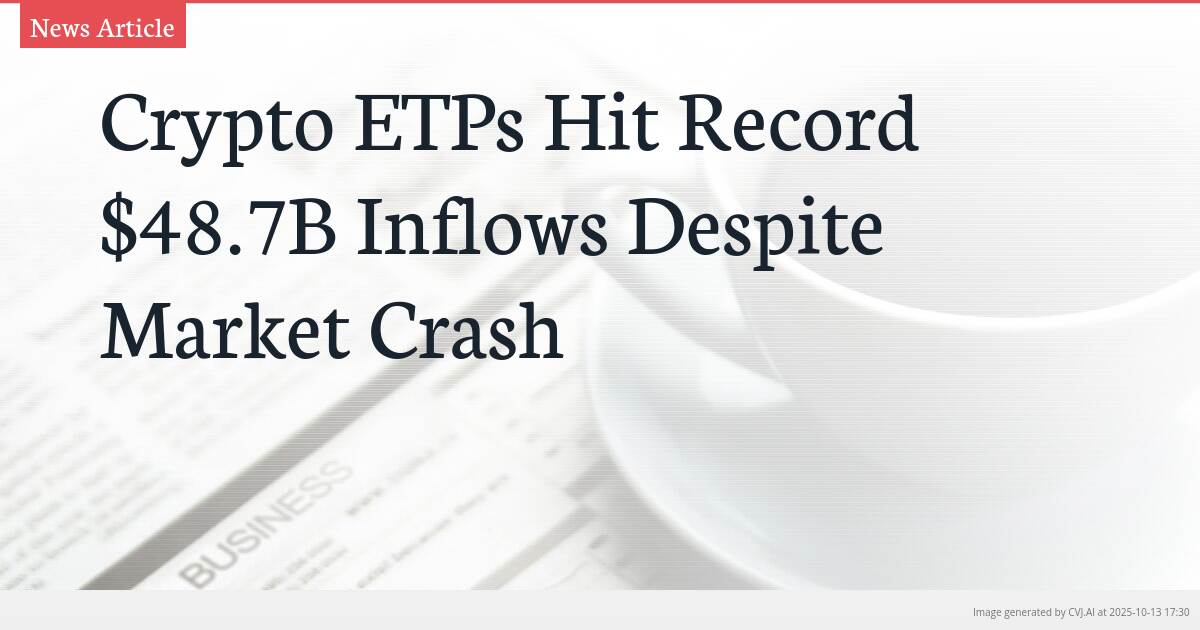This summary text is fully AI-generated and may therefore contain errors or be incomplete.
Introduction
Cryptocurrency exchange-traded products demonstrated remarkable resilience during last week’s market turmoil, attracting $3.17 billion in inflows that pushed 2025’s total to a record-breaking $48.7 billion. Despite Friday’s dramatic flash crash that wiped out $600 billion in paper value, ETF outflows remained minimal at just $159 million, revealing unexpected stability in investor confidence amid global trade tensions between the U.S. and China.
Key Points
- Weekly crypto ETP volumes hit record $53 billion, double the 2025 average
- Retail investors proved 'stickier' than institutions during market volatility
- Leveraged traders on centralized exchanges suffered massive liquidations while DeFi saw less impact
Record Inflows Defy Market Volatility
The cryptocurrency ETP market achieved unprecedented momentum last week, with Bitcoin funds pulling in $2.6 billion and Ethereum funds attracting $338 million in new deposits according to data from crypto asset manager CoinShares. This substantial inflow brought the year-to-date total to $48.7 billion, already surpassing last year’s record flows. James Butterfill, Head of Research at CoinShares, highlighted the extraordinary trading activity, noting that “weekly volumes on digital asset ETPs were the largest on record at a whopping $53 billion for the week, double the 2025 weekly average.”
Friday’s trading session proved particularly historic, with daily volumes reaching $15.3 billion—the largest single day on record. This surge occurred despite escalating trade tensions between the United States and China that ultimately triggered a market-wide selloff. The timing of these record inflows immediately preceding the crash suggests strong underlying institutional and retail interest in cryptocurrency exposure through regulated investment vehicles.
Minimal ETF Outflows Reveal Investor Resilience
When spot markets tanked on Friday, the reaction from ETP investors was surprisingly muted. Outflows totaled just $159 million—a figure described as “paltry” by Butterfill. This minimal movement suggests that both retail and institutional investors largely held their positions despite the market turmoil. Butterfill’s analysis indicates that retail investors proved particularly resilient, describing them as “much ‘stickier’ than institutional investors, who often engage in basis trading.”
The research suggests that institutional investors engaged in basis trading—buying long spot positions while shorting futures—would typically be expected to drive outflows during such events. However, Butterfill noted that “there was no evidence of this on Friday flows, so it seems that the institutional basis trades (who really move the flows) were not impacted much.” This unexpected stability in institutional positioning, combined with retail investors’ tendency to hold through volatility, created a surprisingly stable ETP landscape amid market chaos.
Flash Crash Wipes Billions, But Recovery Underway
The Friday market crash had devastating consequences for leveraged traders, particularly those using perpetual contracts on centralized exchanges. Marcin Kazmierczak, co-founder of crypto oracle company RedStone, described the carnage: “Within hours, the total cryptocurrency market capitalization fell from around $4.3 trillion to approximately $2.7 trillion, wiping out nearly $600 billion in paper value.” The rapid decline triggered “massive liquidation cascades” as collateral values plummeted momentarily.
However, the damage was notably less severe in decentralized finance ecosystems. Kazmierczak attributed this resilience to two key factors: “Firstly, major oracles such as Chainlink and RedStone kept reporting price feeds from multiple venues, being immune from flash crashes at some exchanges. Secondly, there was simply less leveraged on-chain positions.” This structural difference protected DeFi participants from the worst of the liquidation spiral that devastated centralized exchange traders.
The recovery has been swift and pronounced. Bitcoin has rebounded nearly 3% in the last day to about $114,200 after briefly dipping below $110,000 over the weekend—a level it hadn’t seen in two weeks. Ethereum’s recovery has been even more impressive, surging more than 7% to $4,118 according to data from crypto price aggregator CoinGecko, after spending most of the weekend below $4,000.
Sentiment Indicators Show Cautious Market Psychology
The Crypto Fear & Greed Index provides insight into the psychological impact of the crash, sinking as low as 24 on Sunday—solidly in the “extreme fear” range. By Monday morning, it had improved to 38, moving back into the “fear” zone but still reflecting significant market anxiety. This sentiment is echoed on prediction market Myriad, owned by Decrypt parent company Dastan, where roughly 62% of predictors believe the index will remain below 55 on October 15.
This pessimistic outlook has intensified recently, with the percentage of predictors expecting continued fear jumping by more than 13% in the past day. Despite the strong price recovery and resilient ETP flows, market participants remain cautious about the near-term trajectory. The disconnect between institutional investment flows and retail sentiment indicators suggests a complex market psychology where capital continues flowing into the space even as fear metrics remain elevated.
📎 Read the original article on decrypt.co

